| On this page | |
| Since | 18.0 |
Overview ¶
Many renderers have custom settings that can be set on a per-geometry basis, such as sampling rates, motion blur control, and dicing quality. These properties are not generally applicable enough to be part of the USD standard, but can be very important for batch rendering targeted at a specific renderer.
These geometry settings are different from the settings on a Render Settings primitive because they do not affect the rendering of the entire scene. They only affect the targeted geometry primitives. Renderer-specific light settings are already provided on the Light LOP itself, and so will not appear on this node.
This node provides a way to set these renderer-specific setting on a set of geometry primitives.
Note
To find out how to add parameters for a third-party renderer, see “USD Hydra: Customizing for Houdini” in the HDK documentation.
Inheritance ¶
-
Individual renderers can set values from these parameters as USD attributes, or as primvars. (Karma sets them as primvars.)
-
Storing the settings in primvars allows them to be inherited down the scene graph hierarchy, so it is easier to apply a particular setting to large numbers of geometry primitives.
How to ¶
-
Specify the geometry primitives you want to apply settings to in the Primitives parameter.
-
Use the pop-up menu to the left of the parameters to control how the node authors the opinion for that setting.
Pop-up menu item
Meaning
Set or Create
Sets the attribute to the given value, whether it previously existed or not.
Set if No Authored Value
Sets the attribute to the given value if the attribute currently has no authored value, otherwise this does nothing.
Set if Exists
Only set the attribute to the given value if it previously existed.
Use this mode to make sure an attribute is only set on primitives of the correct type. For example, only
UsdGeomSphereprimitives are likely to have aradiusattribute.Append Prims
For relationships, append to the existing list of targets.
Prepend Prims
For relationships, prepend to the existing list of targets.
Remove Prims
For relationships, remove values from the existing list of targets.
Add
For simple numeric types, add to the existing value.
Multiply
For simple numeric types, multiply by the existing value.
Block
Makes the attribute appear to not exist, so it takes on its default value. (If the attribute doesn’t already exist on the prim, this does nothing.)
Disconnect Input
Deletes the attribute input connection to its source. Input connections take precedence over attribute values, so disconnecting an input allows the attribute value to take effect.
Do Nothing
Ignore this parameter, don’t create or change the attribute in any way.
Parameters ¶
Sampling Behavior
Cooking this node can generate many USD time samples, rather than just a single time sample at the current time. This can be equivalent to having a Cache LOP following this node, but it will evaluate much faster, and does not cache data from any other nodes. This allows animated data to be authored to USD without introducing a node time dependency which would then cause all following nodes to also be time dependent. This can vastly improve playback performance of some LOP Networks.
In all sampling modes, if a parameter on this node does not vary with time, and does not rely on other time sampled data from the stage, only a single default value will be generated in USD for the corresponding attribute. USD time samples are only generated for parameters that may vary over time.
Sample Current Frame
A single time sample will be generated for the current time.
Sample Frame Range If Input Is Not Time Dependent
If the input to this node is time dependent, this node behaves as if it is in Sample Current Frame mode. Otherwise it behaves as if it is in Sample Frame Range mode.
Sample Frame Range
The Start/End/Inc parameter is used to generate multiple times at which this node’s parameters are evaluated, and a USD time sample is created for each attribute at each one of these times.
Start/End/Inc
When the Sampling behavior is Sample Frame Range, this parameter controls the number and spacing of base time samples to be generated by this node. The default values of this parameter are @fstart, @fend, and @finc. These values correspond to the start, end, and step size of the global Houdini animation settings when interacting with Houdini. When using a ROP node to generate a range of frames, these values correspond to the start, end, and increment values specified on the ROP node being executed. This default ensures that a USD file written to disk will contain time samples for exactly the frame range requested by the ROP (regardless of the Houdini animation settings).
Subframe Sampling
For each primary sample generated by this node, these parameters can cause additional samples to be generated around that primary sample time. This is most often used to ensure that accurate data exists at exactly the camera shutter open and close times, as well as at the primary sample time.
Shutter
Controls the method used to specify the shutter open and close times relative to the primary sample times.
Specify Manually
The Shutter Open/Close parameter values provide exact offset values relative to the primary sample time.
Use Camera Prim
The Camera Prim parameter provides the scene graph path of a camera primitive from which the shutter open and close times are extracted to provide the offset values relative to the primary time sample.
Shutter Open/Close
When Shutter is set to Specify Manually, these two offset values are added to the primary sample time to indicate the shutter open and close times. The open time should be less than or equal to zero, and the close time should be greater than or equal to zero.
Camera Prim
When Shutter is set to Use Camera Prim, this is the scene graph path of a camera prim on the input node’s stage. The shutter open and close attribute values are read from this primitive.
Samples
The number of subframe samples to create for each primary sample. These samples are evenly distributed between the shutter open and close times. Note that such an even distribution may or may not create a sample at exactly the primary sample time.
Always Include Frame Sample
When turned on, forces a sample to be created at exactly the primary sample time. If the Samples value, together with the shutter open and close times, already place a sample at the primary sample time, turning on this option has no effect. Otherwise, this option causes an addition sample to be added. This means that the actual number of samples per primary sample may in fact be one more than the number specified in the Samples parameter.
Primitives
The primitive(s) the node should operate on. You can drag primitives from the scene graph tree pane into this textbox to add their paths, or click the Reselect button beside the text box to select the primitives in the viewer, or ⌃ Ctrl-click the Reselect button to choose prims from a pop-up tree window. You can also use primitive patterns for advanced matching, including matching all prims in a collection (using
/path/to/prim.collection:‹name›).
You can drag and drop a specific (or multiple specific) USD prim(s) from the Scene Graph Tree into the window to run validation on only these USD primitives.
Note
This parameter needs to be exposed in order for the transform handles to be context-aware. Without it, the handles may not be positioned properly.
Initialize Parameters
Changes the state of all control menu parameters to Do Nothing, so that this node will not apply any changes. Also grabs the current values of each property from the first Primitives match, and sets the values of the corresponding parameters to match. This means that changing any parameter’s control menu to Set or Create mode will set the property to its current value, making it easier to apply changes to an existing value rather than setting a brand new value. With Rebuild Render-Specific Parameters you reset all parameters from render-specific tabs to their default values for the specific node. If you want to reset the parameters for the entire scene, you can also open the top-level Render menu and choose Rebuild All Render-Specific LOP Parameters.
Karma ¶
Enable Motion Blur
Whether to enable motion blur. Changing this in the display options will require a restart of the render.
Motion Samples from Stage
Instead of choosing the motion samples explicitly, Karma can also choose the motion samples based on the samples authored on the USD stage. This option will choose just the right number of samples to capture the motion described on the stage.
This setting applies to both transform and deformation motion samples for both geometry and instances.
Note
If the samples on the stage don’t align with the shutter times on the camera, it’s possible there will be some minor interpolation issues over the first and last segments (since motion will be truncated rather than interpolated).
Velocity Blur
This parameter lets you choose what type of geometry velocity blur to do on an object, if any. Separate from transform blur and deformation blur, you can render motion blur based on point movement, using attributes stored on the points that record change over time. You should use this type of blur if the number points in the geometry changes over time (for example, a particle simulation where points are born and die).
If your geometry changes topology frame-to-frame, Karma will not be able to interpolate the geometry to correctly calculate motion blur. In these cases, motion blur can use a velocities and/or accelerations attribute which is consistent even while the underlying geometry is changing. The surface of a fluid simulation is a good example of this. In this case, and other types of simulation data, the solvers will automatically create the velocity attribute.
Note
In Solaris, velocities, accelerations, and angularVelocities attributes are equivalent to v, accel, and w in SOPs, respectively.
No Velocity Blur
Do not render motion blur on this object, even if the renderer is set to allow motion blur.
Velocity Blur
To use velocity blur, you must compute and store point velocities in a point attribute velocities. The renderer uses this attribute, if it exists, to render velocity motion blur (assuming the renderer is set to allow motion blur). The velocities attribute may be created automatically by simulation nodes (such as particle DOPs), or you can compute and add it using the Point Velocity SOP.
The velocities attribute value is measured in Houdini units per second.
Acceleration Blur
To use acceleration blur, you must compute and store point acceleration in a point attribute accelerations. The renderer uses this attribute, if it exists, to render multi-segment acceleration motion blur (assuming the renderer is set to allow motion blur). The accel attribute may be created automatically by simulation nodes, or you can compute and add it using the Point Velocity SOP.
When Acceleration Blur is on, if the geometry has an angular velocity attribute (w), rapid rotation will also be blurred. This should be a vector attribute, where the components represent rotation speeds in radians per second around X, Y, and Z.
When this is set to Velocity Blur or Acceleration Blur, deformation blur is not applied to the object. When this is set to Acceleration Blur, use the Geometry Time Samples parameter to set the number of acceleration samples.
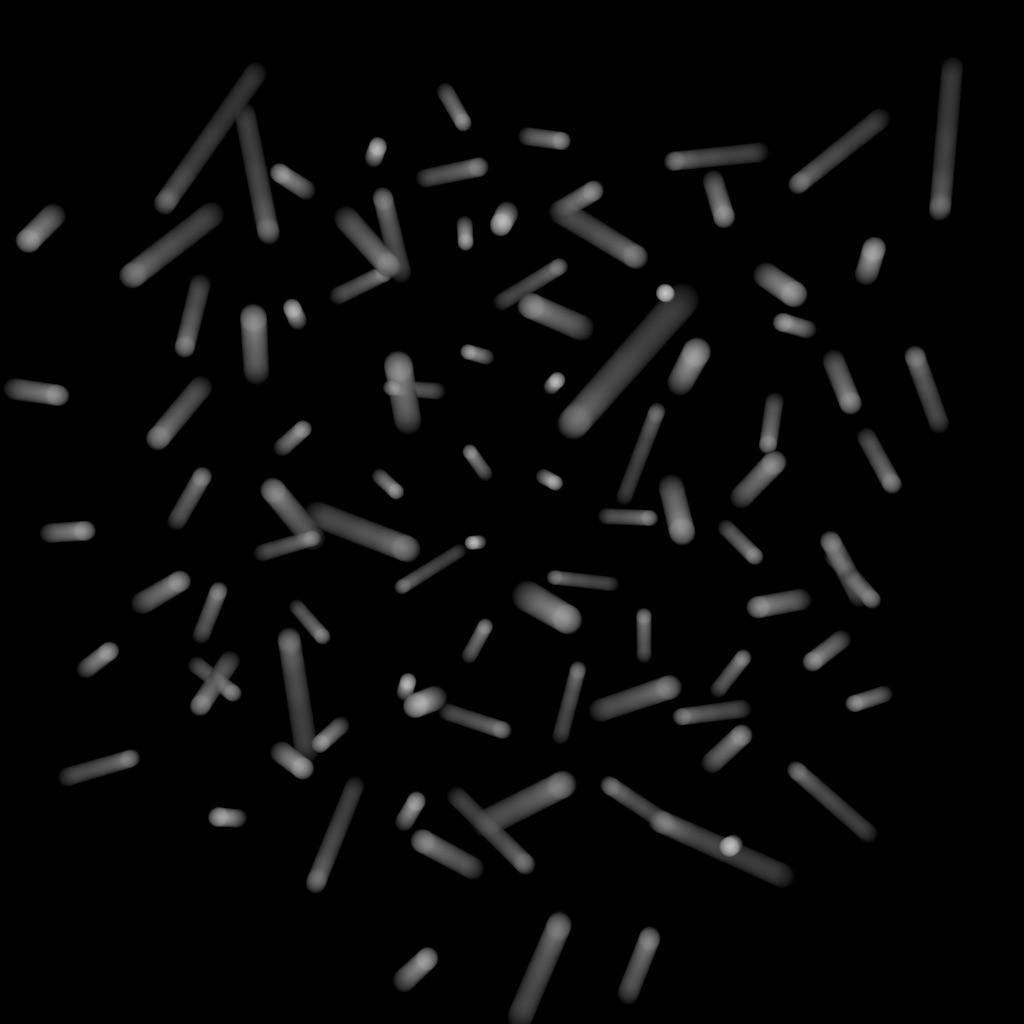
velocities) to do linear motion blur.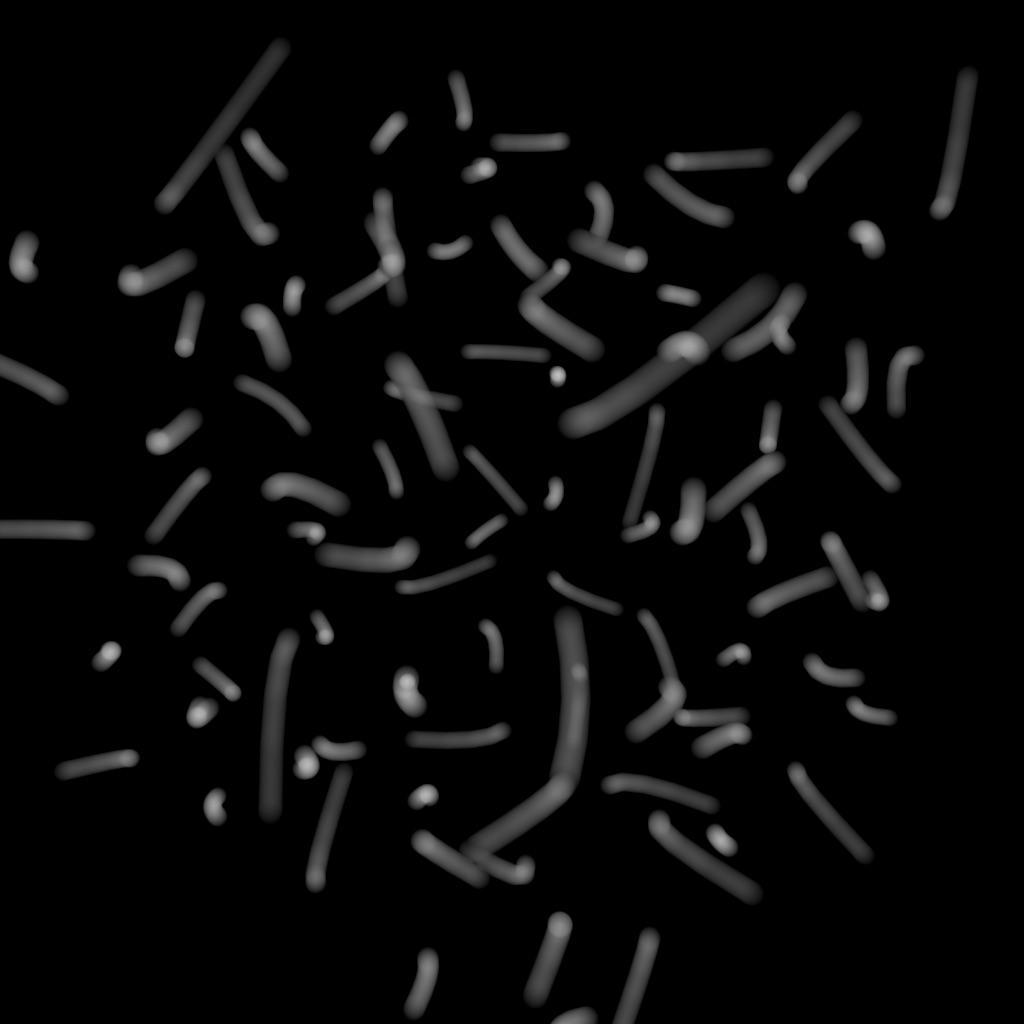
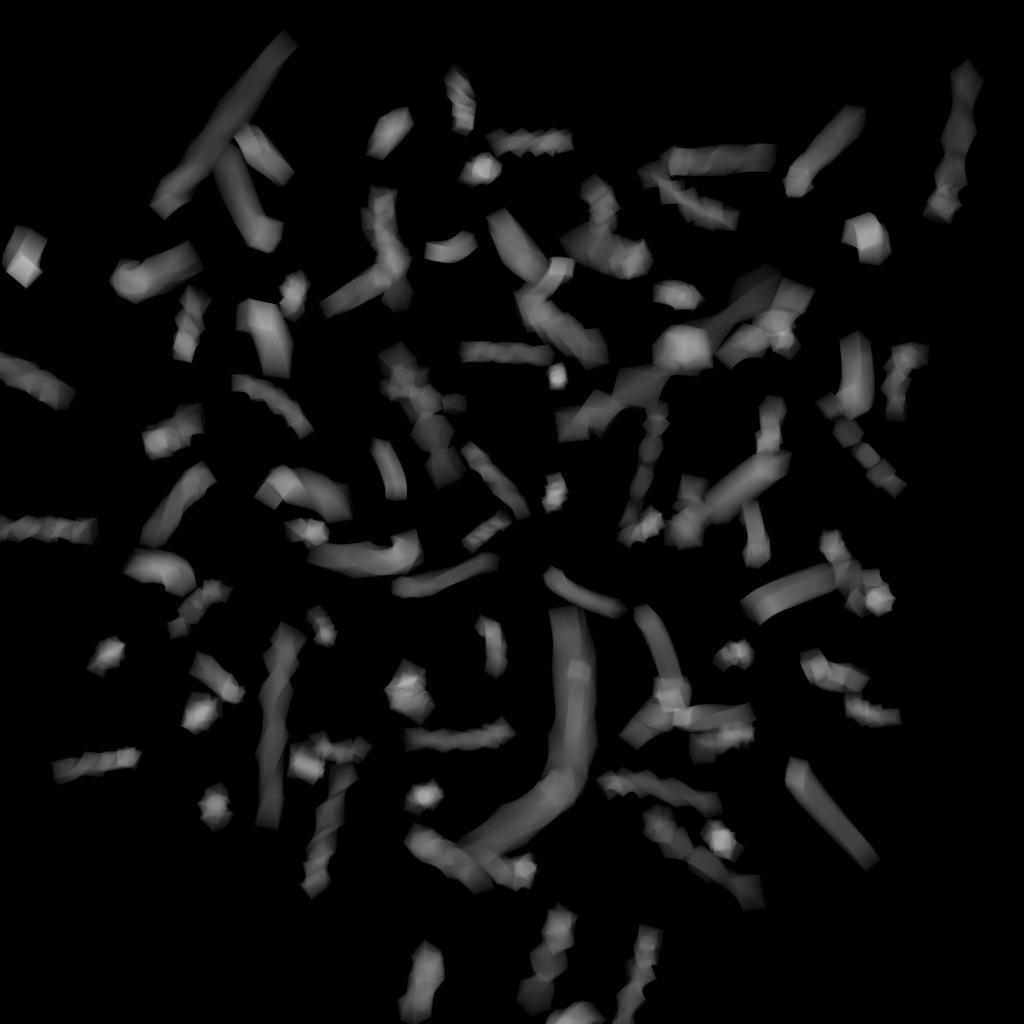
Geometry Time Samples
The number of sub-frame samples to compute when rendering deformation motion blur over the shutter open time. The default is 2 and this value is sufficient to properly blur rapidly deforming geometry. Note that Geometry Time Samples is limited by the number of sub-samples available in the USD file being rendered. An exception to this is the USDSkel deformer.
“Deformation” may refer to simple transformations at the Geometry/SOP level, or actual surface deformation, such as a character or object which changes shape rapidly over the course of a frame.
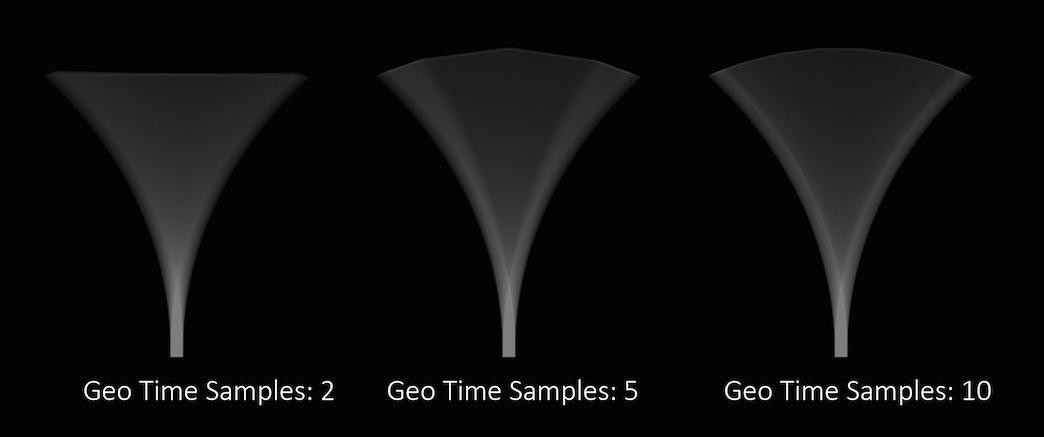
Objects whose deformations are quite complex within a single frame will require a higher number of Geo Time Samples.
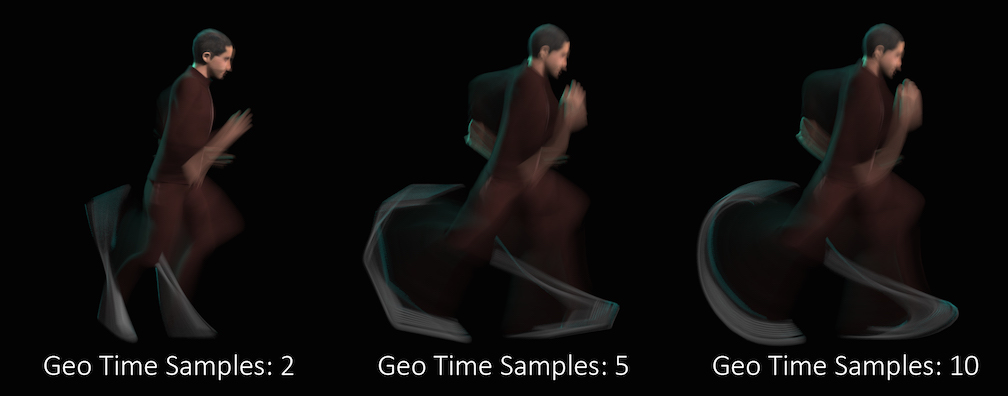
Deformation blur also lets you blur attribute change over the shutter time. For example, if point colors are changing rapidly as the object moves, you can blur the Cd attribute.
Increasing the number of Geometry Time Samples can have an impact on the amount of memory Karma uses. For each additional sample, Karma must retain a copy of the geometry in memory while it samples across the shutter time. When optimizing your renders, it is a good idea to find the minimum number of Geometry Time Samples necessary to create a smooth motion trail.
Deformation blur is ignored for objects that have Velocity motion blur turned on.
For this parameter to override the samples on stage, you must also turn off the Motion Samples From Stage parameter.
Note that specifying the number of samples with this parameter may cause Karma to interpolate data from the samples written on the stage. It’s recommended that you simply use the Motion Samples from Stage setting to let Karma use the data that’s available. This setting may be required if you're using acceleration blur.
Transform Time Samples
The number of samples to compute when rendering transformation motion blur over the shutter open time. The default is 2 samples (at the start and end of the shutter time), giving one blurred segment.

If you have objects moving and changing direction extremely quickly, you might want to increase the number of samples to capture the sub-frame direction changes.

In the above example, it requires 40 transformation samples to correctly render the complex motion that occurs within one frame. (This amount of change within a single frame is very unusual and only used as a demonstration.)
Transformation blur simulates blur by interpolating each object’s transformation between frames, so it’s cheap to compute but does not capture surface deformation. To enable blurring deforming geometry, increase karma:object:geosamples.
For this parameter to override the samples on stage, you must also turn off the Motion Samples From Stage parameter.
Note that specifying the number of samples with this parameter may cause Karma to interpolate data from the samples written on the stage. It’s recommended that you simply use the Motion Samples from Stage setting to let Karma use the data that’s available.
Motion Blur Style
Specifies the style of motion the object has.
Rotation Blur (default)
Rotates the object around the origin. This is ideal for objects that spin.
Linear Blur
This style of motion will not preserve the volume of rotating objects and will have linear motion instead of rotational arcs. Should only be used in special cases, i.e. with pivot transformations. Linear blur linearly interpolates the coefficients of the transformation matrix to achieve a correct blur.
Instance Velocity Blur
When defining motion blur on instances, the transform of each instance can be blurred in addition to any motion blur occurring on the prototype. This option controls how the instance will compute the motion blur of the transform on each instance. For example, when instancing prototypes to a particle system, you'd likely want to use velocity blur to compute motion blur (the transform on the prototype would be blurred by the velocity on the particles).
No Velocity Blur
Use deformation blur of the instance to compute the blur on the transform.
Velocity Blur
To use velocity blur, the instance must be a point instancer with a velocities attributes on the points, or a native instance with a v primvar.
The velocities attribute (or v primvar) value is measured in Houdini units per second.
Acceleration Blur
To use acceleration blur, the instance must be a point instancer with point velocities and acceleration values. The renderer uses this attribute, if it exists, to render multi-segment acceleration motion blur (assuming the renderer is set to allow motion blur). The accel attribute may be created automatically by simulation nodes, or you can compute and add it using the Point Velocity SOP; this will be converted to
accelerations when the SOP geometry is converted to USD.
Instance Motion Samples
When motion blur on instances is computed using Acceleration Blur or Deformation Blur, this parameter specifies the number of motion segments used for motion blur.
Volume Velocity Blur Mode
Choose velocity blur method for volumes.
Lattice Deformation
Motion sampled via a deforming superstructure.
Lookup Offset
Sample coordinate is offset by velocity field value.
Note
Lattice Deformation mode can produce results with higher quality and handle cases such as disparate features of a volume overlapping post-blur. Lookup Offset mode can be more performant, particularly with reduced-resolution velocity fields. However, this mode is more prone to clipping issues if the sampled position is outside the bounds of velocity field. There, the lattice doesn’t have velocity information.
Volume Velocity Blur Scale
Velocity multiplier used to reduce or exaggerate amount of motion blur on volumes.
Volume Velocity Lattice Quality
Controls the resolution of the lattice super structure that is used for volume motion blur. Values closer to 1 result in a structure with velocities closer to the original velocity data, but longer render time.
Diffuse Quality
This parameter acts as a multiplier on Min Secondary Samples and Max Secondary Samples for indirect diffuse component.
Reflection Quality
This parameter acts as a multiplier on Min Secondary Samples and Max Secondary Samples for indirect reflect component.
Refraction Quality
This parameter acts as a multiplier on Min Secondary Samples and Max Secondary Samples for indirect refract component.
Volume Quality
This parameter acts as a multiplier on Min Secondary Samples and Max Secondary Samples for indirect volume component.
SSS Quality
This parameter acts as a multiplier on Min Secondary Samples and Max Secondary Samples for SSS component.
Volume Step Rate

How finely or coarsely a volume is sampled as a ray travels through it. Volumetric objects are made up of 3D structures called Voxels, the value of this parameter represents the number of voxels a ray will travel through before performing another sample.
The default value is 0.25, which means that every one of every four
voxels will be sampled. A value of 1 would mean that all voxels are
sampled and a value of 2 would mean that all voxels are sampled twice. This
means that the volume step rate value behaves in a similar way to pixel
samples, acting as a multiplier on the total number of samples for
volumetric objects.
Keep in mind that increasing the volume step rate can dramatically increase
render times, so it should only be adjusted when necessary. Also, while
increasing the default from 0.25 can reduce volumetric noise, increasing
the value beyond 1 will rarely see similar results.
Volume Shadow Step Rate
A factor to proportionally decrease the volume step rate only for shadows,
relative to the volume step rate. Smaller values will cause Karma to use a
larger ray march step size for shadow rays than other shading rays. A
value of 1 will produce equal quality for shadow rays and shading rays.
Volume Sampling Field
Specifies the volume field by name that will be used for empty space culling. By default Karma will use the 'density' field if it exists. If you are rendering an emissive volume in which some parts of the volume have a 0 density, but still need to be rendered, you should specify a different field using this parameter.
Volume Filter
Some volume primitives can use a filter during evaluation of volume
channels. This specifies the filter. The default box filter is fast to
evaluate and produces sharp renders for most smooth fluid simulations. If
your voxel data contains aliasing (stairstepping along edges), you may need
to use a larger filter width or smoother filter to produce acceptable
results. For aliased volume data, gauss is a good filter with a filter
width of 1.5.
-
point -
box -
gauss -
bartlett -
blackman -
catrom -
hanning -
mitchell
Volume Filter Width
This specifies the filter width for the Volume Filter property. The filter width is specified in number of voxels. Larger filter widths take longer to render and produce blurrier renders, but may be necessary to combat aliasing in some kinds of voxel data.
Secondary Noise Level
Noise threshold to determine the number of indirect rays cast for indirect bounce when the Convergence Mode is set to Automatic. Decreasing this threshold (for example, to 0.001) will theoretically send more indirect rays and decrease noise, however the “extra” rays will likely be cancelled out by the Max Ray Samples parameter. The correct way to decrease noise is to increase the number of samples per pixel, rather than change this threshold.
If you are using Variance Pixel Oracle, you should set the same value for both threshold parameters. Setting the oracle’s threshold lower may make the indirect component reach its threshold sooner and cast fewer indirect rays, but the oracle decides to cast more expensive camera rays because the amount of final noise in the beauty pass is higher than the oracle’s threshold.
Min Secondary Samples
Minimum number of rays to cast in per-component variance anti-aliasing.
Max Secondary Samples
Maximum number of rays to cast in per-component variance anti-aliasing.
Diffuse Limit
The number of times diffuse rays can propagate through your scene.
Unlike the Reflection Limit and Refraction Limit, this parameter will increase the overall amount of light in your scene and contribute to the majority of global illumination. With this parameter set above zero diffuse surfaces will accumulate light from other objects in addition to direct light sources.



In this example, increasing the Diffuse Limit has a dramatic effect on the appearance of the final image. To replicate realistic lighting conditions, it is often necessary to increase the Diffuse Limit. However, since the amount of light contribution usually decreases with each diffuse bounce, increasing the _Diffuse Limit beyond 4 does little to improve the visual fidelity of a scene. Additionally, increasing the Diffuse Limit can dramatically increase noise levels and render times.
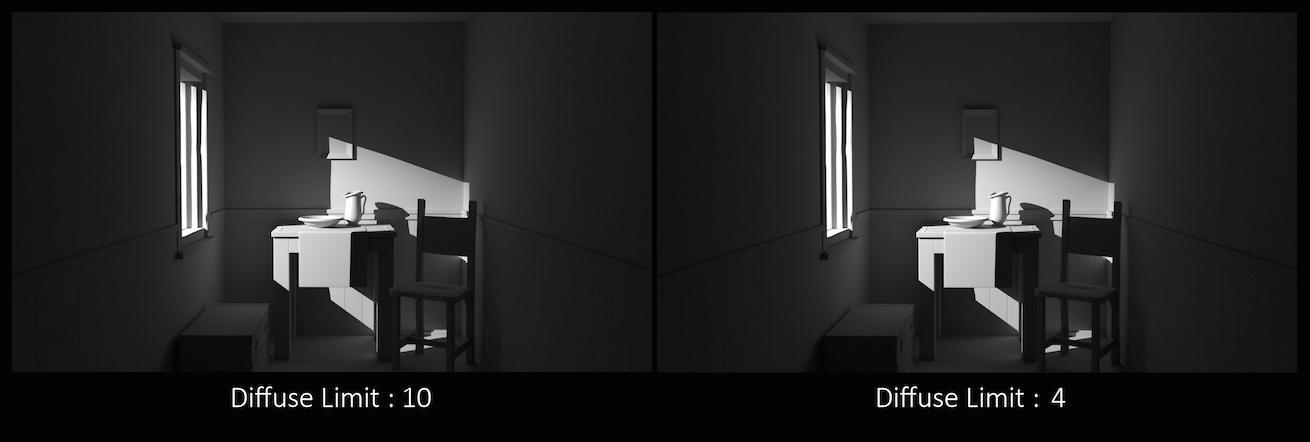
This is a float because all limits are stochastically picked per-sample, so for example you can set the diffuse limit to 3.25 and have 25% of the rays with a diffuse limit of 4 and 75% of rays with a diffuse limit of 3.
Reflection Limit
The number of times a ray can be reflected in your scene.
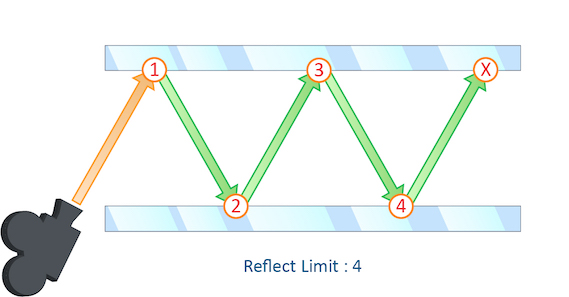
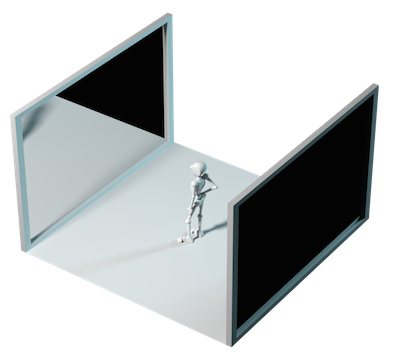
This example shows a classic “Hall of Mirrors” scenario with the subject placed between two mirrors.
This effectively creates an infinite series of reflections.

Remember that the first time a light source is reflected in an object, it is considered a direct reflection. Therefore, even with Reflection Limit set to 0, you will still see specular reflections of light sources.



From this camera angle the reflection limits are very obvious and have a large impact on the accuracy of the final image. However, in most cases the reflection limit will be more subtle, allowing you to reduce the number of reflections in your scene and optimize the time it takes to render them.
This is a float because all limits are stochastically picked per-sample, so for example you can set the diffuse limit to 3.25 and have 25% of the rays with a diffuse limit of 4 and 75% of rays with a diffuse limit of 3.
Refraction Limit
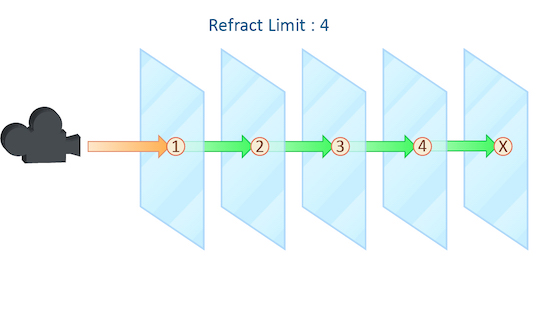
This parameter control the number of times a ray be refracted in your scene.
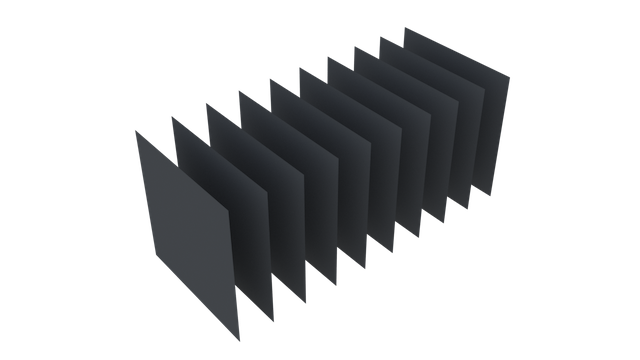
This example shows a simple scene with ten grids all in a row.

By applying a refractive shader, we will be able see through the grids to an image of a sunset in the background.
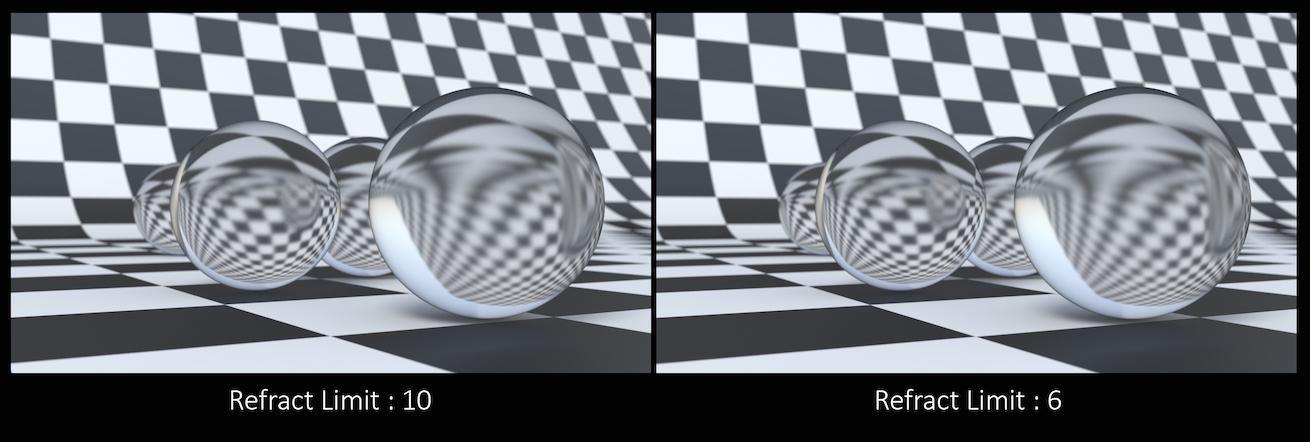
From this camera angle, in order for the image to be accurate, the refraction limit must match the number of grids that that are in the scene. However, most scenes will not have this number of refractive objects all in a row and so it is possible to reduce the refract limit without affecting the final image while also reducing the time it takes to render them.
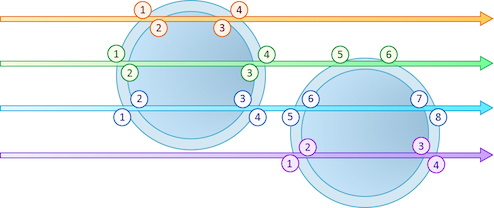
Keep in mind that this Refraction Limit refers to the number of surfaces that the ray must travel through, not the number of objects.
Remember that the first time a light source is refracted through a surface, it is considered a direct refraction. Therefore, even with __Refraction Limit___ set to 0, you will see refractions of light sources. However, since most objects in your scene will have at least two surfaces between it and the light source, direct refractions are often not evident in your final render.
This is a float because all limits are stochastically picked per-sample, so for example you can set the diffuse limit to 3.25 and have 25% of the rays with a diffuse limit of 4 and 75% of rays with a diffuse limit of 3.
Volume Limit
The number of times a volumetric ray can propagate through a scene. It functions in a similar fashion to the Diffuse Limit parameter.

Increasing the Volume Limit parameter will result in much more realistic volumetric effects. This is especially noticeable in situations where only part of a volume is receiving direct lighting. Also, in order for a volumetric object to receive indirect light from other objects, the Volume Limit parameter must be set above 0.

With the Volume Limit set to values above zero, the fog volume takes on the characteristic light scattering you would expect from light traveling through a volume. However, as with the Diffuse Limit, the light contribution generally decreases with each bounced ray and therefore using values above 4 does not necessarily result in a noticeably more realistic image.
Also, increasing the value of this parameter can dramatically increase the amount of time spent rendering volumetric images.
This is a float because all limits are stochastically picked per-sample, so for example you can set the diffuse limit to 3.25 and have 25% of the rays with a diffuse limit of 4 and 75% of rays with a diffuse limit of 3.
SSS Limit
The number of times a SSS ray can propagate through a scene. It functions in a similar fashion to the Diffuse Limit parameter.
This is a float because all limits are stochastically picked per-sample, so for example you can set the diffuse limit to 3.25 and have 25% of the rays with a diffuse limit of 4 and 75% of rays with a diffuse limit of 3.
Limit Components
The ray types that the bounce limit color is applied to.
Limit Color
The color that will be used when a specific ray type reaches the limit.
Uniform Volume
Whether to render this object as if it was a uniform-density volume. Using this property on surface geometry is more efficient than actually creating a volume object of uniform density, since the renderer can assume that the volume density is uniform and place samples more optimally. The surface normal of the surface is used to determine which side of the surface will render as a volume - the normal will point away from the interior. The surface need not be closed - if the surface is not closed, the volume will extend an infinite distance away from the surface. Non-closed surfaces may produce unexpected results near the edge of the surface, so try to keep the viewing camera away from the edges.
Uniform Volume Samples
The number of samples to generate when rendering a uniform volume
(karma:object:volumeuniform is enabled). The samples will be distributed
so as to produce an equal image contribution if they were all equal in
brightness. Note that this property has no effect when global Screendoor
Limit is greater than 0, so for all practical purposes it is deprecated.
Render Visibility
Controls the visibility of an object to different types of rays using a category expression. This parameter generalizes the Phantom and Renderable toggles and allows more specific control over the visibility of an object to the different ray types supported by karma and VEX.
|
Rays sent from the camera |
|
Shadow rays |
|
Diffuse rays |
|
Reflections |
|
Refractions |
For example, to create a phantom object, set the expression to -primary. To create an unrenderable object, set the expression to an empty string . These tokens correspond to the string given to “raystyle” in the VEX trace() and gather() functions.
Stencil Map
This map type controls polygon visibility without invoking the shading engine. This means that you typically don’t need an opacity map on the shader/material. The stencil map uses the default texture coordinates (st) to do a quick unfiltered texture evaluation. By default, any pixel with a value of 0 makes the polygon invisible to any rays. However, you can change this limit with Stencil Threshold.
Stencil Threshold
Pixels with values less than or equal to this threshold will be invisibles to rays.
Cusp Angle
If there are no normals on an object, any edges with a dihedral angle greater than this value will be cusped. For compatibility with Mantra, Karma will also look for a detail attribute named vm_cuspangle (which takes priority over the setting).
Holdout Mode
When this is set to Matte mode, the object will be considered to be a cutout matte. Any lighting contribution and alpha of the object will be redirected to LPE AOVs with “holdouts” prefix. Holdout Mode does not affect the utility AOVs such as ray:hitP and ray:hitN.
Background mode is similar to Matte, except it’s used for background plate so it will appear “pre-lit” in indirect bounces, multiplied by shadow contribution. Diffuse albedo of the shader is used to determine the pre-lit irradiance.
Fix Shadow Terminator
Adjust shading position of shadow rays to avoid self-shadowing artifacts on low-poly meshes due to the discrepancy between smooth normals and face normals.
Custom Tracesets
A space-separated list of custom traceset names. You can use tracesets to subdivide a mesh into different parts, i.e. in conjunction with the Karma Texture Baker LOP. For example, the clothing on a character might have tracesets like
pants, shirt and jacket. On the Karma Texture Baker LOP’s Bake Traceset parameter you can then define which part/traceset you want to bake.
LPE Tag
Custom label assigned to lights or objects for use with Light Path Expressions.
Enable Internal Reflection
Lets you evaluate the internal reflection on the backface of a glossy transmissive BSDF. Turn on this option to apply internal reflections. Note that this option has no effect on MaterialX Standard Surfaces with Thin Walled turned on: these materials always show internal reflections.
Internal reflections can cause black areas on an object’s back faces due to a loss of energy. To avoid this, turn off Enable Internal Reflection.
Thinwall at Refract Limit
Paths can become trapped inside refractive objects due to total internal reflection, hitting the refract/reflect limits and causing dark artifacts. Thinwall At Refract Limit treats surfaces as “thin walled” once these limits are reached, allowing further hits to pass through without bending or reflecting. This helps paths escape refractive objects without needing high refract/reflect limits (improving both look and performance).
SSS Traceset
Custom traceset for random walk subsurface scatter. Without a traceset, random walk will only trace against itself. With a traceset, it will trace against every geometry in the scene that shares the same traceset name.
Note
With instancing, this property must be defined on the prototype. Per-instance tracesets are not supported.
Direct Refraction Subset
For compound BSDFs with refractive components, only apply direct lighting for lights that belong in specified location. A light ray facing the same direction as geometry normal is considered Outside. For transparent material that are solid/closed-manifold, setting this parameter to Outside can improve render performance by reducing noise in direct lighting and cut down on wasted shadow rays.
Dielectric Priority
Specifies the priority of a refractive material, allowing the renderer to
choose which of many overlapping refractive materials should take precedence
while rendering. This enables effects like water in a glass with ice cubes.
The default (highest priority) is 0, and as the number increases (1, 2, 3, etc.), the priority decreases.
Bump Shadow Terminator
Softens harsh shadow transitions from strong bump or normal maps. The shadow terminator is smoothly blended up to the specified threshold (in radians). A value of 0 disables the effect.
Enable Caustics
Brute-force caustics from transmissive objects. Allows evaluation of glossy BSDF that’s seen by indirect diffuse bounce. Often requires a significantly higher number of diffuse rays to resolve, especially if Roughness Clamp parameter is set to very small value or Indirect Guiding feature is disabled.
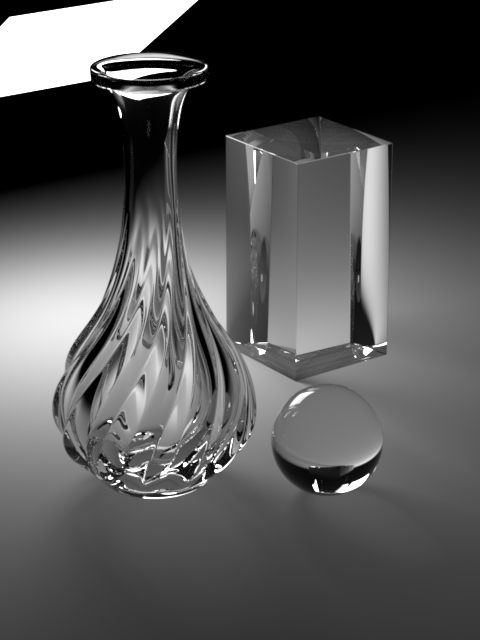
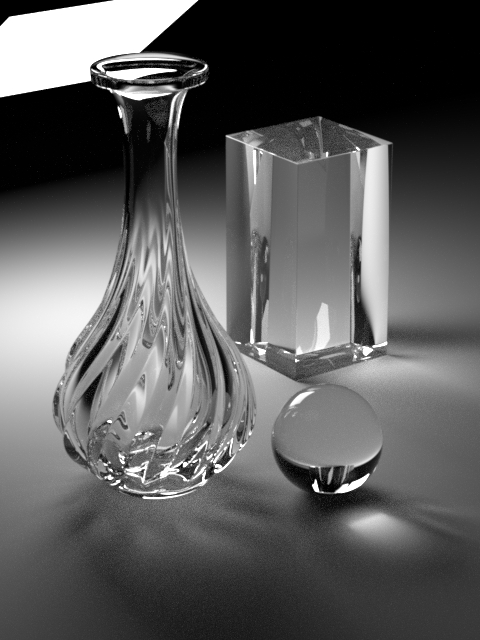
Roughness Clamp
Forces a minimal roughness for true caustics, above what the shader has set. Increasing this value can make caustics less noisy at the cost of accuracy.
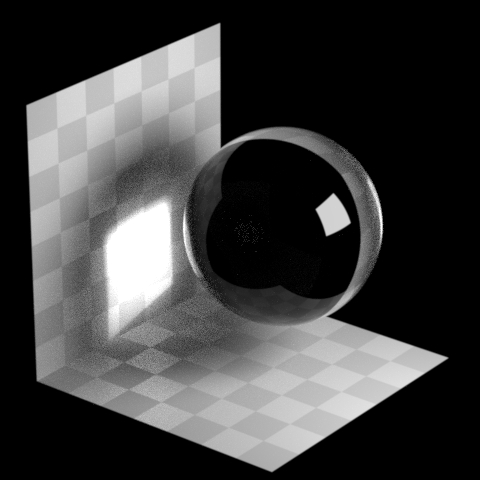
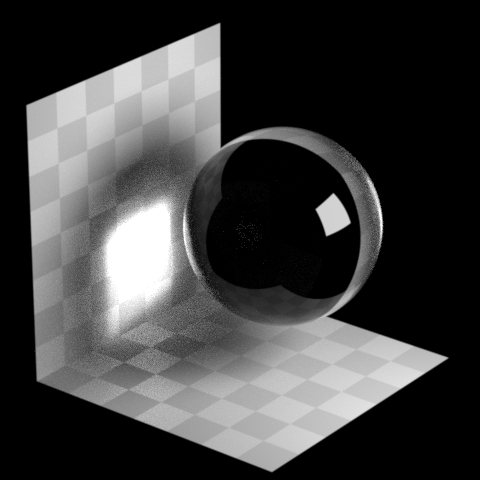
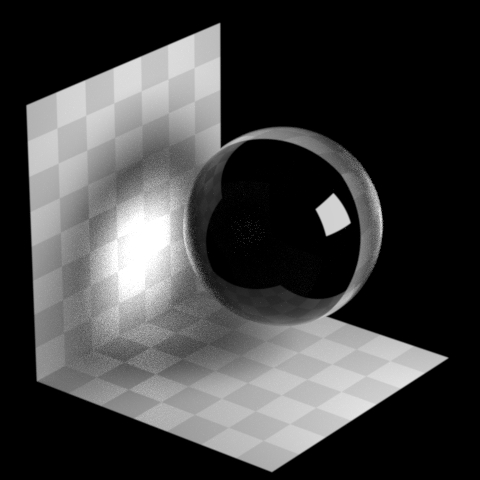
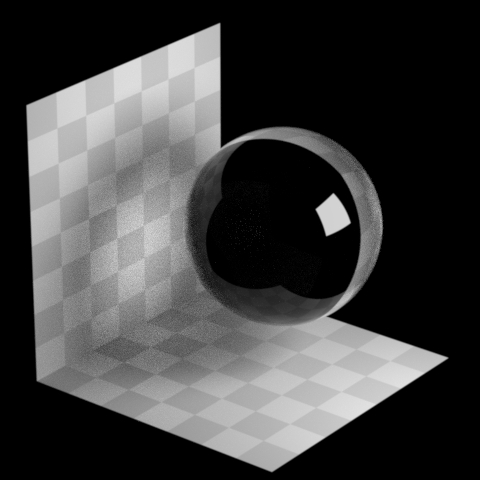
Note
Roughness clamp only works with GGX BSDF and may not have any effect with Phong, cone, or specular BSDFs.
Evaluate BSDF on Fake Caustics
Allows the BSDF to affect the fake caustics, meaning that, for example, a red bottle will automatically cast red shadows. Disabling the BSDF can reduce render times, but means Color should be used instead to set a constant shadow color.
Color
Tints the fake caustics. Use this to darken the result of the BDSF, or to set a constant shadow color if the BSDF is disabled.
Opacity
Controls the opacity of fake caustics. Use this to lighten the result of the BDSF.
Fresnel Darken
Controls the darkening of the Fresnel effect on the fake caustics shadow. A value of 0 turns the feature off and value of 1 fully darkens the shadow.
Efficient Emissive Sampling
Any object with an emissive material will generate light within the scene. If an object is significant enough (e.g. size, brightness, etc…) then it is possible for Karma to treat that object as if it were an explicit light source (similar to regular lights), meaning the emitted light will be handled much more efficiently. But doing so will add extra overhead elsewhere in the system (e.g. increased memory usage, slower update times, etc…).
There are three options. No will set the object as not being a light source. Yes will set the object as being a light source. Auto (default) means Karma will use an internal heuristic to decide if the object should be treated as a light source.
Is Portal
When enabled, the object will turn into a “light portal” that only lets in certain portion of dome lights based on portal geometry visibility.
Portal Dome Lights
Space-separated list of dome lights to associate this portal with.
Render Points As
When rendering point clouds, they can be rendered as camera oriented discs, spheres or discs oriented to the normal attribute.
Render Curves As
When rendering curves, they can be rendered as ribbons oriented to face the camera, rounded tubes or ribbons oriented to the normal attribute attached to the points.
Override Curves Basis
USD supports Curve Basis types that may not be supported directly in Houdini. In some cases, you may want to override the Houdini curve basis. For example, if you have linear curves in Houdini, you may want to render them with a Bezier, B-Spline or Catmull-Rom basis. This menu will force Karma to override the basis that’s tied to the USD primitives.
Note that the topology of the curves must match the target basis. For
example, when selecting any cubic curve basis, every curves must have at
least four vertices. For the Bezier basis, curves must have 4 + 3*N vertices.
Width Scale
A uniform scale applied to point and curve widths. This can be used to adjust the size of points and the radius of curves without having to modify the geometry.
Cull Backface
If enabled, geometry that are facing away from the camera are not rendered.
Dicing Quality
This parameter controls the geometric subdivision resolution for smooth surfaces (subdivision surfaces and displaced surfaces). With all other parameters at their defaults, a value of 1 means that approximately one micropolygon will be created per pixel. A higher value will generate smaller micropolygons meaning that more shading will occur - but the quality will be higher.
The effect of changing the shading quality is to increase or decrease the amount of shading by a factor of karma:object:dicingquality squared - so a shading quality of 2 will perform four times as much shading. A shading quality of 0.5 will perform 1/4 times as much shading.
True Displacements
This setting controls how the displacement shader on the object will be run.
Bump Mapped Displacement
The displacement shader is run, but only modifies the surface normal. This does not dice geometry and can save memory. With Karma XPU, this option only works in conjunction with float-based displacement maps. Also make sure to set the MtlX Image VOP’s Signature drop down menu to Float. Vector-based displacement maps are not supported in Karma XPU with this mode turned on.
Please also note that this mode generally doesn’t work with Karma XPU when you mix two or more MtlX Standard Surface VOPs.
True Displacement
The geometry is diced and displaced. This will cause proper silhouettes and shadowing of displaced surfaces.
Disable Displacement Shader
Disable the displacement shader entirely. There will be no bump mapping or displaced geometry.
Dicing Minimum Depth
When not set to -1, Karma will set minimum number of rows and columns on each face to be 2 to the power of this value when dicing for subdivision or displacement.
Dicing Maximum Depth
When not set to -1, Karma will set maximum number of rows and columns on each face to be 2 to the power of this value when dicing for subdivision or displacement. Setting the same (or lower) value as Dicing Minimum Depth is effectively equivalent to fixed parametric subdivision that ignores raster space/offscreen measurement. Recommended leaving this value at -1.
Dicing Predisplace
Enable this to apply trial displacement prior to dicing for improved raster space measurement. This helps avoid undertessellation with extreme displacements or when offscreen geometry is supposed to enter camera frustum post-displacement.
Low Resolution Object ID
Defines this object as the low resolution object corresponding to said Texture Baking Object ID. This means that the texture space of this object is what is being baked. If no high resolution object exists for this Object ID, this is the rendered appearance for the texture in that space as well. This is required for texture baking.
Cage Object ID
Defines this object as the cage object corresponding to said Texture Baking Object ID. This means that this object is used to help resolve normal discontinuities during texture baking of the low resolution object. This is optional for texture baking.
High Resolution Object ID
Defines this object as the high resolution object corresponding to said Texture Baking Object ID. This means that the rendered appearance of this object is what is being baked into the texture space the low resolution object. This is optional for texture baking.
Identifier Traceset
The name of the traceset on the high resolution object. A bake_traceset string primvar is also required on the low resolution object. When both, Identifier Traceset name and primvar, match, the object will be visible to primary rays.
Visibility Traceset
The traceset that is defined through Identifier Traceset. When availavle, it indicates which objects are visible to secondary rays, for example ambient occlusion, curvature, thickness, cavity, etc.
Visibility Cull Backface
If enabled, geometry that are facing away from the secondary ray (Ao, Cu, Cv, Th, etc.) are not intersected.
Enable
Per object lines on/off.
Radius
Controls outline thickness. Arctangent of this parameter determines the cone angle to cast stencil rays to do edge detection. It will be multiplied by karma:global:outline_radius.
Contour
Contour detection on/off. Contour lines are based on automatically assigned object id if
export_outline_id is not provided as a value or texture (as shader export).
Id Threshold
Threshold which estimates how different is id values of the main ray and stencil ray.
Crease
Crease lines for hard surfaces on/off.
Crease Threshold
Threshold which estimates how N direction changes in the area of stencil radius.
Depth
Depth lines on/off.
Depth Threshold
Threshold which estimates how z-depth values changes in the area of stencil radius.
Secondary
Indirect lines on/off.